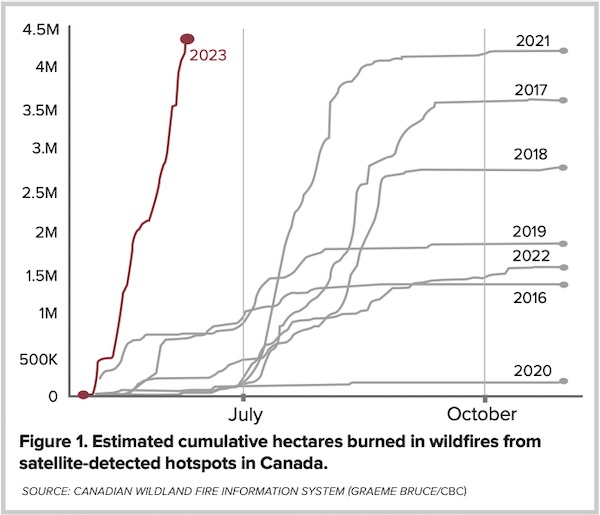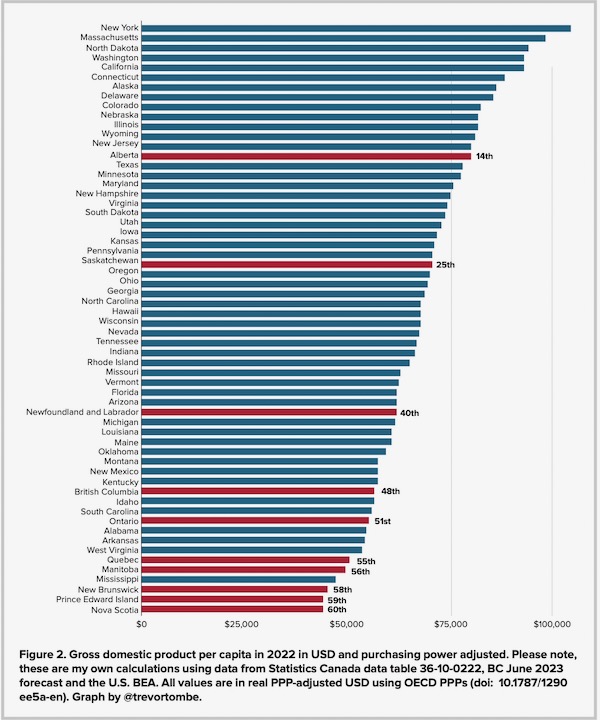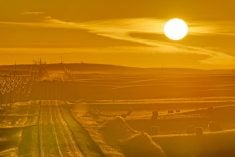In this column, I’d like to discuss two items, wildfires and economic efficiency, which at first glance appear unrelated, but are they?
Once again, climate alarmists are using a truly unfortunate situation for political gain and justification of their anti-oil positions. Admittedly, in Figure 1, the 2023 data looks scary, but the overall graph is illuminating.
As of the middle of June, Alberta had experienced 609 wildfires. Investigations have determined the cause of 449 of them with 155 still under investigation. Of the 454 with a known cause, 350 or 77 per cent are determined to have been caused by humans. The United States is experiencing a very light forest fire season this year, with more than 90 per cent being caused by humans, according to the National Interagency Fire Center.
Read Also

Gentle treatments for pain in the neck
Heading toward year-end, people unknowingly tense up against the cold and busyness, causing neck pain that can often be treated with appropriate support and gentle mobility, athletic therapist Kathlyn Hossack says.

Now have a look at 2020. Almost zero fires. What else happened in 2020? We were asked to stay home because of COVID-19 and many parks were closed. If climate change causes forest fires, why were there none in 2020?
Numerous factors predispose forests to fire with the most important being drought, a normal cyclical occurrence. The two largest ignition sources are careless people and lightning. Flicking cigarette butts out of vehicle windows is sheer reckless behaviour. Why is no one calling out this kind of carelessness?
I think I can answer that! It doesn’t fit the narrative. The narrative that fossil fuels are destroying the planet. In fact, the Alberta premier was criticized for pointing out, factually, that most fires were caused by humans. It’s also time to resurrect Smokey Bear and the fire prevention education of a half century ago.
The horrible fire season of 2023 no more proves that climate change is occurring than 2020 disproves it. But that doesn’t prevent many in the media and politicians from ad nauseously placing blame on climate change.
Economic efficiency
And now onto a seemingly unrelated item of economic efficiency or per capita GDP. Gross domestic product is a combination of the number of people in a country multiplied by how much each person produces, or per capita GDP. Canadian per capita GDP has been almost flat this past decade, with U.S. per capita GDP now eclipsing Canada’s by a staggering 40 per cent.
Per capita GDP is directly correlated with standard of living. A nation can’t increase its citizens’ standard of living without increasing per capita GDP, other than by temporarily running higher deficits. However, when financial markets insist on governments paying off debt, as they did to Canada in the 1980s and ’90s, it pulls that money back out of the economy.
It’s like people with inadequate means deciding to live it up in bars and restaurants, charging everything to a credit card, instantly increasing their standard of living. But when the tab gets too large and the credit card company insists on payment, they can no longer frequent those bars and restaurants and need to cut other expenses. Voilà! Their standard of living goes back down, and then some.
There are several items contributing to Canada’s dismal per capita GDP record:
- We are a resource-based economy and the past decade, until recently, has been awful for resources.
- Excessive regulation is a frictional cost on the economy.
- There has been a lack of efficiency producing capital investments driven by an unfavourable investment climate.
- There is an ever-increasing number of government employees in comparison to private employment, since 2020 government employment is up 9.4 per cent, while private sector employment is up just 0.4 per cent. That’s part of the answer to the question about where did the workers go? This trend has been going on for a decade with federal civil servants up an astounding 40 per cent since 2015. Logically, you need more civil servants to administer additional regulations, like the new underutilized real estate return. Excessive regulation is therefore a double whammy on economic efficiency as it dissuades investment while requiring additional civil servants.
- Exchange rate, which is a measuring stick for economic performance, also factors into per capita GDP.
There are other contributing items, but I believe those are the big ones. One more astounding statistic is that since 2020 Canada has added more civil servants than the United States, an economy 12 times larger than ours. That’s a significant amount of additional economic overhead.
It is interesting that despite Alberta and Saskatchewan’s main industry being challenged for a decade, the most capitalistic of the provinces are the ones with the highest per capita GDP. There is little doubt that socialism reduces per capita GDP and, thus, the overall standard of living.

The connection
Which brings me back to the forest fires/climate change topic and a connection between these seemingly disparate topics, making this the most important statement in the column: When there is a perpetual boogeyman that is blamed for virtually everything, it keeps us from addressing real, underlying issues.
A singular focus on C02 keeps us from addressing other critical environmental issues, like garbage. This singular focus is also keeping us from addressing, and is in fact leading to, economic inefficiency as we move to less efficient energy sources. While wind and solar power sources have improved, there remains consistency and energy storage issues. I would submit we would do much more for the environment by focusing on efficiency, producing more output with less input, reducing resources utilized.
A clear example of how we are forcing inefficiency is carbon capture and storage. From what I have read, somewhere between $15 to 20 billion is being spent to put C02 into the earth’s crust. This is capex that could be invested in efficiency measures (or unrelated needed capex like hospitals), but instead must be spent on a non-productive pursuit.
There are very few things that I will guarantee you, but this is one: Putting C02 into the earth’s crust in Fort McMurray will not change the weather! Similarly, sending more taxes to Ottawa will not change the weather either.
In no way do I mean to imply that I understand all of the factors involved in these complex topics. My main point is that it appears we have stopped looking for the answers as we are blaming the boogeyman, climate change, for so much that befalls us.
For further reading, I just finished Landscapes & Cycles: An Environmentalist’s Journey to Climate Skepticism by Jim Steele. I have now read two, pro-climate change books and two skeptical climate change books. It’s important to look at both sides and it’s also clear which books are providing the most compelling arguments.
















